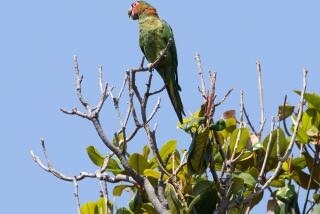Famous Midway Atoll Left to Fabled Gooney Birds
MIDWAY ISLAND — The Pacific atoll of Midway, which gave its name to one of the decisive battles of World War II, has become a land ruled by gooney birds.
Almost deserted by the U.S. military for which it played a vital role for over 30 years, the tiny island is home to an estimated 1 million black-footed albatrosses, popularly known as gooney birds.
Another half-million birds of other species, all protected under U.S. law, also live there.
Secretary of State James A. Baker III stopped on Midway to refuel recently on a trip to Asia and he and the journalists accompanying him were treated to a tour of the island.
“It will be a short tour. The island is only a mile wide and a mile and a half long,” warned Lt. Dan Messing, one of 11 military personnel stationed on Midway.
Actually, there are several islands at Midway, enclosed by a reef with a circumference of about 15 miles. But only one is inhabited.
Baker, who takes a keen interest in wildlife, had asked to see gooneys. He need not have worried, they were everywhere.
Messing said most of the young had already flown out to sea, where they would spend six or seven years before returning to Midway to nest. But there were still several thousands ungainly late developers sitting around--on the runway, in the roads, on the island’s nine-hole golf course, under the trees, on the beach--in fact, everywhere.
“Sometimes they nest on the greens on the golf course. If a ball comes near them, they think it is an egg and start sitting on it,” Messing said.
Crews of men have to clear the runway of gooneys before planes come in and prior to takeoff. The men patiently shooed the birds away to make way for the secretary of state, but they were soon waddling back to their places.
Removing the corpses of up to 7,000 of the creatures that die every week is another vital maintenance job. The birds expire of a disease called “droop wing” or because they were prematurely abandoned by their parents.
Sea turtles abound in the brilliant turquoise sea, seals nest on the shore and sharks prowl the waters of the coral feeding on the young of gooneys who fail on their maiden flights or get washed away to sea before they can fly.
Midway, a coral atoll lying 1,150 miles northwest of Honolulu, has no indigenous population. It was discovered by Americans, annexed in 1867 and given to the U.S. Navy to administer in 1903.
Japanese forces launched a fierce attack on the island in June, 1942, but were intercepted by the U.S. Navy about 200 miles off the coast. The ensuing Battle of Midway is generally regarded as a turning point in the Pacific War.
Midway continued to play a key strategic role well into the 1970s and the era of the Vietnam War. As recently as 1970, Messing said, there were up to 40,000 Marines living on the island in tents.
Today, a high school that bustled with activity two decades ago is abandoned and old living quarters are derelict.
But it is still clear that Midway is part of America. Satellite television beams in everybody’s favorite shows and a sign proudly welcomes visitors to Midway’s shopping mall consisting of two shops, where Midway baseball caps are on sale for $5, the newspaper rack is well stacked with copies of Penthouse magazine, and liquor prices are cheaper than anywhere on the mainland.
Apart from the handful of Navy personnel on one-year tours of duty, the island’s human inhabitants consist of some 250 Asian workers employed in picking up dead birds and other vital maintenance, a small group of civilian engineers employed by the Navy and occasional scientific teams conducting field research.
One such group is studying the effect of termites on wood in hope of developing a new preservative to defend against them. Another group is studying the volcanic development of the Hawaiian archipelago, to which Midway technically belongs.
Messing has been on Midway for 21 months and keeps extending his tour of duty.
“It’s quiet here but I don’t like big cities. Watching those gooneys is kind of peaceful,” he said.
More to Read
Sign up for Essential California
The most important California stories and recommendations in your inbox every morning.
You may occasionally receive promotional content from the Los Angeles Times.









